
Sherman Newlin, Pro Farmer Crop Tour scout, says many regions of South Dakota have seen a 180° turnaround from 2022.
“Last year, this region had very low yields because of drought. This year they’ve been catching a lot of rain,” Newlin says. “There’s no tip back here, yet. The dryness coming up could shrink the grain depth and have a small affect.”
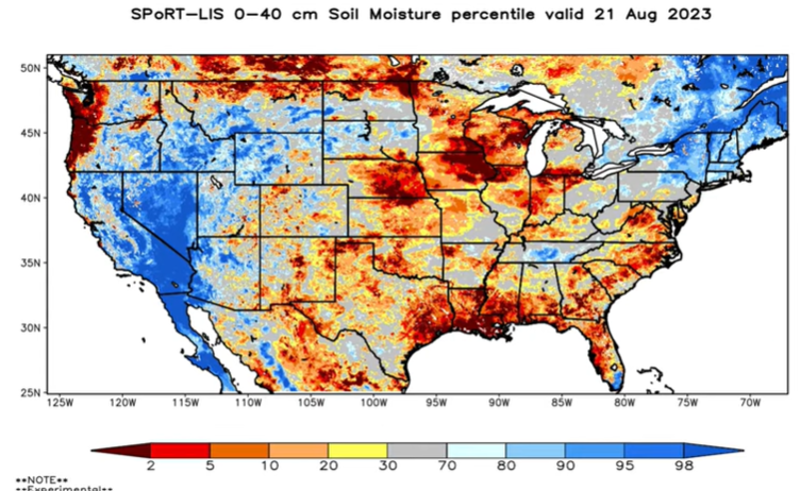 |
Thanks much, cutworm.
I'll get on the latest weather maps for you shortly.
It's just getting too late for weather to be in the drivers seat.
The last wx gasp was Sunday Nights gap higher, which was filled. First with corn, then beans(that have better fundamentals) that ended in a buying exhaustion/failure, gap and crap formation.
Since weather is fading fast, my ability to provide guidance for price direction is waning too but at least this Summer, we've been extremely helpful in tracking and predicting price reactions from some very strong moves.
Since I love weather, I'll stick with the forecasts...........FOREVER!
Even when they aren't moving the markets.
Excessive wetness can be a factor(but that extremely rare and the market knows that it just delays harvest in most cases).
If we had a late/wet crop and it sat in the field, that might be a bigger factor but this is the opposite year for that.
The last early freeze was, I think was September 1995. I made a ton of money on that one but global warming and a crop that is advanced this year make that extremely unlikely.
More on that later.
I forgot about the Pro Farmer tour, thanks for the reminder.
I'll get on that too.
With regards to the September 1995 freeze, this is what I found so far to help jog my memory.
You might remember that event, although it was more of an IL/w.IN event if I remember correctly.
I told an extremely long version of the story and had weather maps/records to go with it but that must have been on the old forum.
https://www.marketforum.com/forum/topic/30726/#30897
In 1995, I just checked my trading records, we had very late planting then a mid Sept freeze which did some serious damage to the beans that were still a couple of weeks away from maturity. Made a ton of money on that event. The freeze was at the start of the 3rd week in September. I'll have to check some weather data. Temps dropped into the mid 20's as far south as S.IL and S.IN, where we didn't get the beans planted until almost late June that year.
+++++++++++++++++++++
Remembering that freeze 28 years ago, It had been extremely dry in Aug/Sept so the ground was bone dry. When the cold/dry air mass came in over the bone dry ground, it didn't pick up any moisture/moderate much so dew points stayed low. With the lengthening nights and clear skies, calm winds the bottom dropped out.
Odds of a SIGNIFICANT early freeze in today's climate for any year are probably 1 in 20 or less.
Dialing in current conditions and the upcoming weather pattern, I would put the odds of a SIGNIFICANT early freeze at less than 1 in 50. But this is purely based on weather maps right now looking into the first week of September.
A huge shift for mid-September to the opposite pattern would increase the odds. That can happen
Update: I'll start a new threat on the freeze topic with some graphics and historical freeze data to go with it. But will try to use this one for the Crop Tour results.
These were the day 1/Monday crop tour results. Karen will be posting updates thru the day on what they are seeing, if you just go to her link below.
+++++++++++
#Corn yields on #pftour23 averaged 5.6% above than last year’s tour in Ohio but a little below 2021. Pod counts for #soybeans were up 11% from last year’s tour and the tour’s highest since 2014.
+++++++++++++
#pftour23 finds South Dakota #corn yield 33% higher than a year ago but well below the 2018 & 2020 tours. Pod counts for #soybeans up 16% YOY but below 3yr tour average.
June 22, 2023
https://legacyseeds.com/2023/06/drought-stress-on-corn-development/
I want to step back for a second for a lesson/review on this years crop, which they are measuring right now with this tour.
The growing season was extremely unique as we shifted into different weather regimes.
1. Beneficial dryness that got much of the crop planted early.
2. Too much of a good thing with the early dryness continuing too long, meant poor emergence for some producers because the soils were TOO dry. Probably some of them had to plant deeper than usual to hit moisture. The early planted corn got established quickly and had roots tapping deeper moisture in June around here and was ok. The late planted corn here, still had shallow roots and was barely surviving in mid June.
3. Severe dryness developed across most of the Midwest by early June and was starting to permanently take away yield potential in the key areas. Personally, based on agronomy 101, I think the corn crop WAS hurt before the rains came later in the month. This is based on the harm the dry period did when EAR GIRTH is determined and possibly ear length. V7 stage is when permanent ear girth potential is really starting to be determined and I'm thinking that most of the crop in the key areas was beyond V7 and will have LESS rows than usual. Length of the ear is determined after that and maybe the rains came in time to salvage length, maybe not in some places? This is needed to maximum row length. Girth determines the number of rows. Rows X length will determine the number of POTENTIAL kernels. So we had weather in early/mid June that was really adverse for setting rows and early row length setting or depending on the maturity/planting date, ear length was more impacted.
4. There are other things that can help make up for this. If pollination weather is good, like it was in 2023, then you can maximize the pollinating of every spot to produce a kernel(no gaps or tip back from hot/dry) and the ear is packed solid with kernels to the tip. If the weather for kernel filling has been ideal. Good rains and no intense heat(the cooler, the better) the number of kernels, even if reduced from earlier season dryness, can really get plump from optimal filling.
This comprehensive thread on heat fill explains it well and shows the difference between the 2009 crop with its cool weather and 2010 crop with its hot(and wet) weather purely from temperatures.
https://www.marketforum.com/forum/topic/97257/
++++++++++++
These were the temps in the Midwest for J-J-A
1. June was odd, with heat in the N.Plains but not the key Cornbelt. Dry thru much of the month, then rains increased greatly the last week. Lack of intense heat in May/June for the main belt is what saved the crop (with help from hybrids and CO2)
2. July temps don't get much better for corn pollination and early filling. This made up for some of the early adversity which probably reduced the number of rows and possibly the length in some places. Rains helped reduce drought.
3. August continued those wonderful temps.....until the last several days. Huge rains came too the first 2 weeks with the Beans an unprecedented +5% in the G/E rating on 8-14-23 report.
4. This weeks intense heat with no rain is taking away a few bushels from gains made earlier this month. This will cause corn plants to accelerate to maturity at breakneck speed and reduce filling time and yields slightly. Soil moisture a week ago was great but after a week of no rain and the profile never fully recharged, there will be some stress from this heat.........but again, it's just too late in the season to do anything except shave a few bushels off a crop size that has been growing every week since late June.
https://www.cpc.ncep.noaa.gov/products/tanal/temp_analyses.php
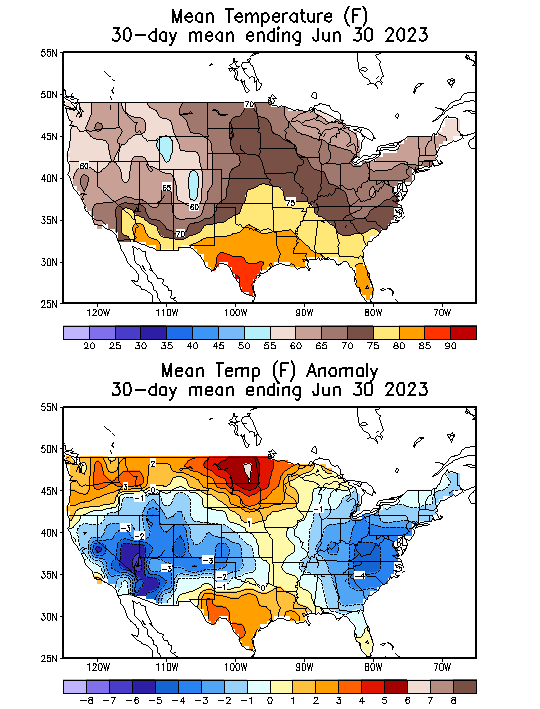
+++++++++++++++++

++++++++++++++++++++++++
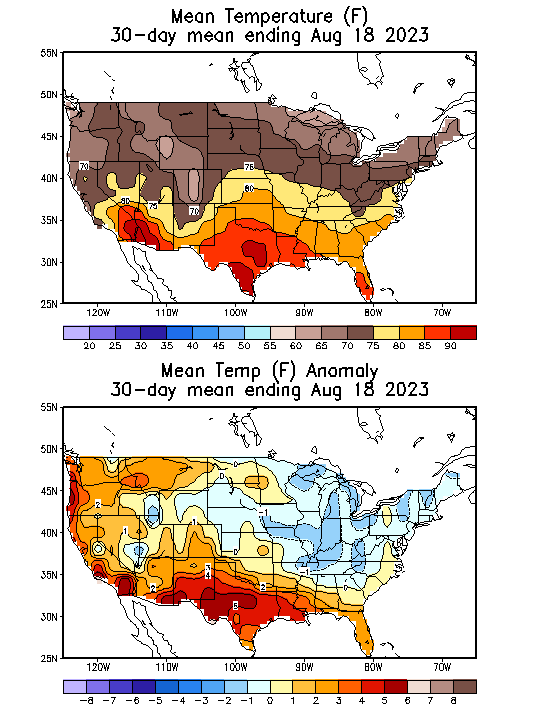 +++++++++++
+++++++++++

#pftour23 finds strong potential in Indiana #soybeans with pod counts nearly matching the 2018 tour’s high. #Corn results could suggest hesitation on USDA’s record yield forecast (tour found 193.5 bu/acre in 2021, Indiana’s record corn yielding year).
+++++++++++
These numbers from #pftour23 aren’t screaming for upside in USDA’s yield estimates for Nebraska #corn & #soybeans, esp. w/ the finishing weather. Really strong results needed in west Neb. All four tours prior to 2022 found pods at 1200+, corn yield is 2nd lowest since 2017 tour.
I've found myself looking at these multiple times already this week. Just leaving them here in case you want to take another look/save them:
metmike: Take note of item #3 on the top list here (underlined/in bold to emphasize):
https://www.marketforum.com/forum/topic/98452/#98466
Not impressed with #corn after 6 stops in west central Iowa (Harrison/Crawford County area). Average 171 bu/acre. Last year was 201 and two years ago 218 through this same stretch. Ears are kinda short. #pftour23
cutworm,
Do you think with so much tipback that maybe the early planted corn was already starting early pollination before the rains came at the end of June/July?
That's my guess.
++++++++++++
15 stops on this route through western Iowa. Avg #corn yield 173 bu/acre. Same route last year 186. Was 200 in 2021. Short ears and/or tipback common. #Soybeans pods in 3x3' plot avg 1247 vs 1313 last year and 1233 in 2021. Not bad but sooo many flat pods still. #pftour23
Found better #corn further north (Cherokee, Buena Vista, Clay Counties) in western Iowa. Five stop average 186.8 bu/acre versus 178.7 on these five stops last year and 199.6 in 2021. It's dry here but the moisture is a little better than in the counties to the south. #pftour23
9 stops in west central Iowa. Average #corn yield 159 bu/acre. Last year along this exact same route over 9 stops it was 188, and it was 200 in 2021. Honestly pretty surprised. High of 192 and low of 127, and first pic is NOT the 192... #pftour23
Mike in my humble opinion that severe kind of tip back is due to 2 things. Drought during and after pollination. See that near the good kernels there are kernels that are not maturing. That is drought after pollination. I think that high heat would cause poor pollination in the middle of the rows along with tip back. Do not see that in the pictures. I have to think that there is a possibility that the kernels will be small. (she said it was dry)
During the period that the corn plant decides how many in a row(ear length) it was still trying to be long. That trait has been breed in that it will try to make more waiting for more rain. Part of drought resistance. But in this case the rain was not enough to fill all the ovals.
It seems to me that Eric Snodgrass has been talking about a hole in Iowa that didn't get the rains about that time. But I am operating from memory which could be wrong.
Average Illinois #corn yields on #pftour23 were the 3rd highest in the last decade (high 197 bu/acre on 2014 tour). Pod counts for #soybeans were the 5th highest in the last decade (high 1329 on 2018 tour). Forecast for Illinois is dry for at least the next week.
Mixed results for #corn in western Iowa on #pftour23. District 4 (west central) yield was the tour’s lowest in at least 9 years, but the NW and SW districts came in similar to the recent tour averages.
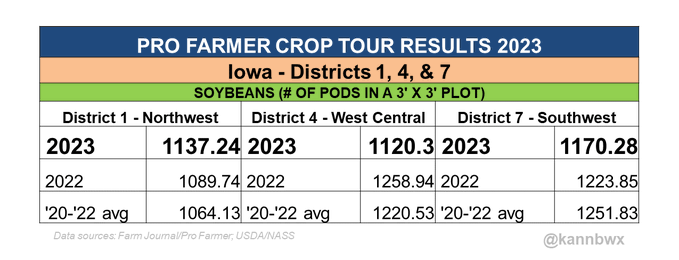
Thanks cutworm!
That makes complete sense to me.
You're right too that the dryness in parts of the cornbelt, including IA was still ongoing until the huge rains came early this month that caused the beans to go +5%.
Rains that late were well after pollination everywhere. ............so there's the tip back.
Iowa #corn yields on #pftour23 come in a little below last year and the recent average. 182.8 is the tour’s 5th lowest of the last decade, and the west central district was hit the hardest by drought this year. Potential for #soybeans is above average, but rains are still needed.
Minnesota #corn yields on #pftour23 were lower than last year and the recent tour average. Numbers in the southeast district were particularly light, reflective of the dry season. Pod counts for Minnesota #soybeans were the tour’s second worst of the last decade.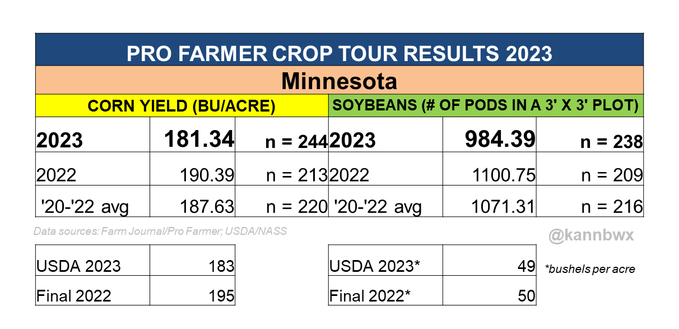
This year, the Pro Farmer tour seemed to be more bullish than bearish, especially the 2nd half(Wed/Thu. In the past, if I remember, they sometimes did this, then when their final numbers came out on Friday it wasn't as bullish as the comments or individual state estimates suggested it should be.
Is my memory right about this?
Will the number on Friday be as bullish as the tour seemed to suggest this week?
What do you think?
https://events.farmjournal.com/pro-farmer-crop-tour-2023/media
Pro Farmer National Crop Production Estimates
Friday, August 25 — Release available at 1:30 pm CST
All interested media can make arrangements with Brian Grete to receive the estimates (embargoed for release at 1:30 p.m. CT).
Friday's Pro Farmer National Crop Production estimate is not a Crop Tour estimate — it is a Pro Farmer estimate. While Pro Farmer obviously uses the data collected on the Pro Farmer Crop Tour and this data obviously plays a huge role in determining the estimate, Pro Farmer’s editors and analysts also consider other factors, such as crop maturity, soil moisture conditions, disease/pest infestation and prospects outside the tour area in arriving at the crop estimate. Because late-season weather can still impact final yields, the Pro Farmer crop estimate will be given in a range of production potential.
Calculation of Statistics:
Corn yields are calculated using a consistent data set: ear populations, grain length in
inches, kernel rows around the ear and row spacing in each field.
Soybean yields are not estimated because two extremely important variables—number of seeds per pod and seed weight—are impossible to measure on a tour of this type. Scouts calculate the number of pods in a 3-foot by 3-foot square — 9 square feet. The pod count allows for comparison to previous tours and helps determine how much of the “bean-making factory” is in production.
District averages are a simple average of all samples collected within that district.
State averages are a simple average of all samples collected within the state.
Historical Statistics:
The final numbers for the Pro Farmer Tour were bullish and consistent with their comments on Wed/Thu, when they went thru key areas of the Cornbelt, especially IA.
Pro Farmer U.S. Crop Estimates
2023:
#Corn yield 172.0 bu/acre, below USDA's 175.1 and the year-ago yield of 173.3.
#Soybeans at 49.7 bu/acre, below USDA's 50.9 but just above last year's 49.5.
PF pegs the corn crop at 14.96 bln bu, soybeans at 4.11 bln bu.
I only know Karen from the thousands of posts/data that I pass on from her site but she seems to be a very nice human being besides providing massive amounts of accurate and credible information in timely fashion.
Honored to have been named Master Scout on #pftour23 - ten tours in the making. I come back every year because I believe in the process and really enjoy the people. I've learned a lot over the years. Pro Farmer puts on a great event, and I'm already looking forward to next year!